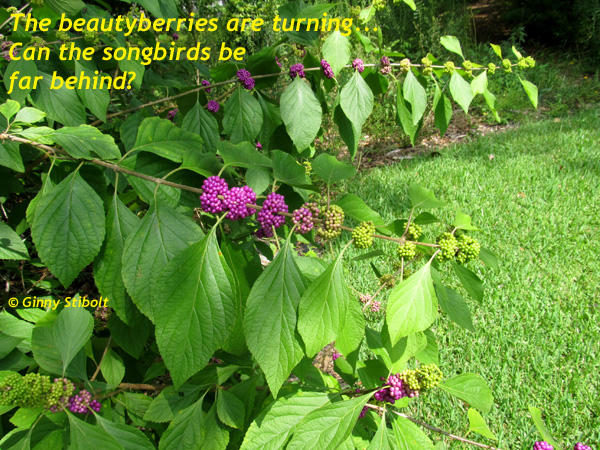Beautyberry is a deciduous shrub with graceful arching branches with opposite leaves. Being in the mint family, crushed leaves are aromatic and can be used as a mosquito repellent. It can grow to eight feet tall and nearly as wide, so plan for that size. It can grow in full sun or partial shade, but it will grow larger and produce more berries in full sun. It is tolerant of various soil types, but does best in a slightly acidic woodland soil. Use this shrub in hedgerows, at the edge of wooded areas, or as a stand-alone shrub. Flowers are borne on new wood. so some people cut it back to the ground in winter every few years to produce a fuller shrub with more stems.
Beautyberry offers good ecosystem services because birds and squirrels eat the berries. The berries are also edible by humans, but are rather bland when eaten raw. They do produce a delightful jelly. The berries can also be used to make a bread. Read my post with a recipe for beautyberry bread where I begin by admitting that harvesting the berries meant that I had robbed the birds. But the bread is really good, so I keep planting more of these shrubs in our yard.
This shrub will self seed. not enough to be weedy, but several per year under each shrub. This keeps us supplied for more plantings on our property with enough to donate to plant sales. I also donated some to the local Audubon chapter for their property that they maintain as a wild area for the birds. I have also started shrubs from cuttings. More than half of them rooted in soil without any rooting hormone.
 |
 |
| Digging seedlings under a beautyberry shrub. | A larger seedling from under a shrub still transplants well. Just be sure to keep it irrigated until the leaves stop wilting. |
 |
| The pale pink beautyberry flowers are not dramatic in the landscape, but they do attract pollinators. |
 |
| The berries are produced on new wood only and turn from green to purple. |
 |
| The berries stay attached through the winter. This photo was taken in February. This makes it an important food source for migrating winter birds. |
 |
 |
| Beautyberry is native to all of Florida. Find this range map and more at The Atlas of Florida Plants. | Beautyberry transplants easily, but planting when dormant is a good idea. So should you purchase this plant? Yes! |
 |
| How beautiful!! |
Green Gardening Matters,
Ginny Stibolt


Is there a limit to how big of a beauty berry bush can me moved?
ReplyDeleteI've not transplanted many large beautyberries, but but they seem to tolerate relocation as long as you provide plenty of irrigation over several weeks until they adjust. You can also take cuttings and root them in damp sandy soil to create new shrubs.
DeleteI just read that they are attractive to deer. Anyone find this to be true?
ReplyDelete